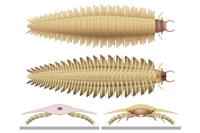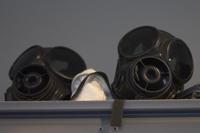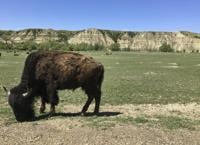WASHINGTON (AP) — As if the largest bug to ever live – a monster nearly 9 feet long with several dozen legs – wasn’t terrifying enough, scientists could only just imagine what the extinct beast’s head looked like.
That’s because many of the fossils of these creatures are headless shells that were left behind when they molted, squirming out of their exoskeletons through the head opening as they grew ever bigger — up to 8 to 9 feet (2.6 meters) and more than 100 pounds (50 kilograms).
Now, scientists have produced a mug shot after studying fossils of juveniles that were complete and very well preserved, if not quite cute.
The giant bug’s topper was a round bulb with two short bell-shaped antennae, two protruding eyes like a crab, and a rather small mouth adapted for grinding leaves and bark, according to new research published Wednesday in .
Called Arthropleura, these were arthropods -- the group that includes crabs, spiders and insects – with features of modern-day centipedes and millipedes. But some of them were much, much bigger, and this one was a surprising mix.
“We discovered that it had the body of a millipede, but head of a centipede,” said study co-author and paleobiologist Mickael Lheritier at the University Claude Bernard Lyon in Villeurbanne, France.
The largest Arthropleura may have been the biggest bugs to ever live, although there is still a debate. They may be a close second to an extinct .
Researchers in Europe and North America have been collecting fragments and footprints of the huge bugs since the late 1800s.
“We have been wanting to see what the head of this animal looked like for a really long time,” said James Lamsdell, a paleobiologist at West Virginia University, who was not involved in the study.
To produce a model of the head, researchers first used CT scans to study fossil specimens of fully intact juveniles embedded in rocks found in a French coal field in the 1980s.
This technique allowed the researchers to scrutinize “hidden details like bits of the head that are still embedded in the rock” without marring the fossil, Lamsdell said.
“When you chip away at rock, you don’t know what part of a delicate fossil may have been lost or damaged,” he said.
The juvenile fossil specimens only measured about 2 inches (6 centimeters) and it’s possible they were a type of Arthropleura that didn’t grow to enormous sizes. But even if so, the researchers said they are close enough kin to provide a glimpse of what adults looked like – whether giant or of a less nightmarish size -- when they were alive 300 million years ago.
___
The Associated Press Health and Science Department receives support from the Howard Hughes Medical Institute’s Science and Educational Media Group. The AP is solely responsible for all content.








































